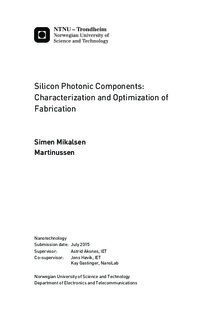Silicon Photonic Components: Characterization and Optimization of Fabrication
Master thesis
Permanent lenke
http://hdl.handle.net/11250/2371447Utgivelsesdato
2015Metadata
Vis full innførselSamlinger
Sammendrag
Photonics is the science of manipulating photons, and silicon photonics is the application of silicon as the optical medium.It leverages the vast body of knowledge about semiconductor manufacturing and the established use of infrared wavelengths in telecommunications to simplify design, manufacture and testing.It also promises a relatively smooth integration of electronics and photonics.
This work lays the foundation for further work with silicon photonics at NTNU.Starting with the bare silicon wafer, it explores the processing from scratch of the necessary materials and the nanostructuring of them to create devices.The entire process flow from the empty wafer to a device in the characterization lab is documented.Silicon-on-insulator wafers are grown using PECVD, and the film quality is evaluated.The wafers are patterned using EBL and etched with ICP-RIE.
The bulk of the work is the development of etching recipes that minimize sidewall roughness.Simultaneously, the lithographic parameters of dose and spatial dimensions are optimized.Two candidate etch recipes are identified and their weaknesses and strengths relative to each other are discussed.
Several mm long waveguides without discontinuities are fabricated, with features such as S-curves and racetrack resonators.These are characterized in an optical setup based on butt coupling with micrometer control of in- and out-coupling fibers, infrared imaging and a photodetector for quantitative measurement.The setup has been characterized and verified to work, however no coupling has been achieved.Suggestions for further work are outlined for the benefit of later researchers.
